The warm nights of June invite you to lie on the ground and stare at the sky. Some folks take this opportunity to do a little camping and see the night sky free of all the clutter and glare of city lights. However, there are so many stars that it's easy to get confused!
You see, the "trick" to learning star identification is ...
If you face southwest soon after sunset during any clear evening in June, you will be confronted with some dazzling stars and constellations. Here's what you will see.
|
In fact, your southern horizon may
be slightly different because of your latitude. This image represents
the view from a latitude of 37o North.
Pretty confusing isn't it! Well, it isn't all that bad. This view, of the southern horizon shows you about a dozen constellations, six of them from the zodiac, and about a hundred stars but only about a dozen of them really stand out. | 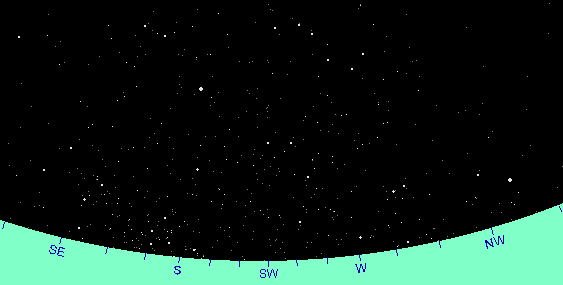 |
Let's get you started by getting you oriented.
Maybe you've already noticed the Big Dipper at the top of the
image. It should be roughly overhead, maybe a little to the west,
soon after sunset (in June). Most folks can find the Big Dipper
unless it's covered by clouds.
Use the handle of the Big Dipper to "arc to Arcturus".
|
I've added some color to Arcturus because, if you look carefully,
you'll see it has a slight orange tinge. This star is the brightest
star in the constellation of Böötes the Herdsman. There
are no rules to drawing constellations, so feel free to draw in
whatever you like.
Once you have found Arcturus continue that line to "speed on to Spica". It's a white star in the constellation of Virgo the Virgin. | 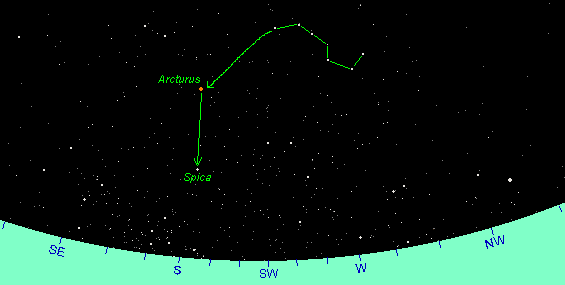 |
Virgo is a zodiac constellation meaning that the Sun passes through it during its annual migration through the sky. On any clear night you should be able to see half of the zodiac - six constellations. Some of these are small or dull but others can really stick out, especially if they have a few bright stars in them.
Immediately to the west of Virgo is the constellation of Leo the Lion.
| This is an easy member of the zodiac to identify. Its brightest star, Regulus (magnitude 1.3) is at the base of a curve of stars that seem to form a question mark ("?"). The curve is meant to be Leo's head and regal Regulus is held in the Lion's front paws. His hind quarters form a triangle with Denebola at the base of his tail. Below (south) of Regulus is Alphard (which might have a slight reddish color to it). | 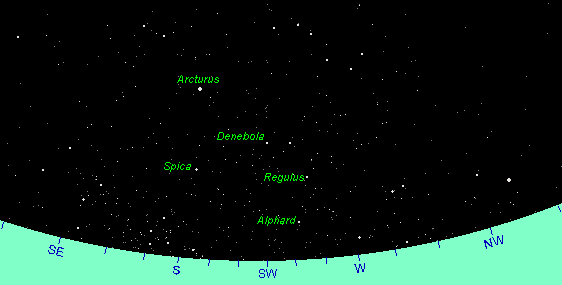 |
Alphard is the only bright star in Hydra the Water Snake. This dim constellation wiggles its way under Leo and Virgo but it's difficult to make it all out.
To the west of Alphard, approaching the horizon (and perhaps it has already set from your location) is Procyon, the brightest star in Canis Minor, the Little Dog. This star has a magnitude of about 0.4 and might have a slightly yellow glow to it. West of Procyon (and even more likely to be hidden) is the top of Orion the Hunter with bright red Betelgeuse on his shoulder.
| If you move up (northwards) from these stars you return to the zodiac. Immediately west of Leo is Cancer the Crab but this is such a small and dim constellation that it is easy to miss. West of Cancer is Gemini the Twins. The reddish star, Pollux, is in the head of one twin while Castor marks the head of the other. Just to the north of the zodiac and approaching the northwest horizon is Capella, a slightly yellowish star in the constellation of Auriga. | 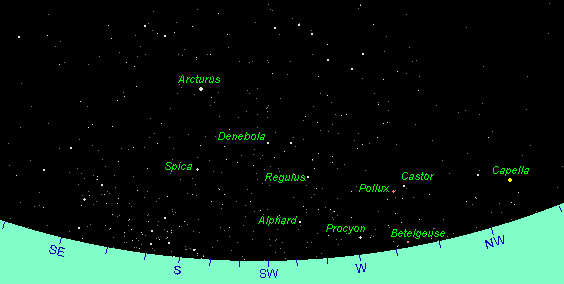 |
There are some nice stars to the east of Spica but it is blood red Antares that really catches my eye.
| This beautiful star is in the heart of Scorpius the Scorpion. Scorpius is a large and intricate member of the zodiac. Its long curved tail is below the horizon in this image but about an hour later you would see all of the scorpion. Ahead (to the west) of Antares is a series of stars that mark out the scorpion's claws. About midway between Antares and Spica is the dim constellation of Libra the Scales, another member of the zodiac. | 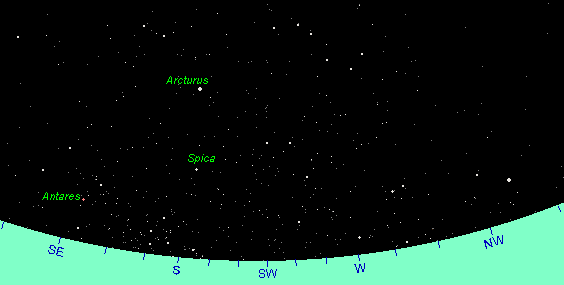 |
Obviously there are many other stars and constellations in this view but I think that is enough to get you started and enjoying these warm summer nights. Here's a reversed color image you might want to print out in order to remember these sights.
The solstice occurs on June 21st. During the solstice the Sun reaches its highest or lowest "altitude" in the sky. This event is actually caused by the tilt (angle) of the Earth's axis with respect to its orbit. It really has nothing to do with the Sun. However, we use the Sun as our point of reference - imaging that the Earth is stationary with the Sun moving around it - so it's a biased view. Also, the name "Summer Solstice" is biased towards observers in the Northern Hemisphere. If, for example, you live in New Zealand then on June 21st you would see the Sun reach its lowest altitude along its most northerly path across the sky and it would be your Winter Solstice. The overall effect of this "Sun path" is that on June 21st, folks in the Northern Hemisphere experience a day with maximal daylight while folks in the Southern Hemisphere have the shortest "day" of the year. In other words, summer starts for folks in the north (a "Summer Solstice") while winter starts for folks in the south (a "Winter Solstice") on June 21st.
|
Your sky map for the month of JuneHere's a map of the clear, night sky as seen from the center of the USA on the first evening of this month, an hour after sunset. Specifically, this is the view of a clear sky from a latitude of 37N. Star-gazers farther north, such as in Minneapolis, Chicago and most of Europe, will have more of the northern sky visible and the southern sky will be obscured by the horizon. Vice versa for those who are farther south. The stars will not change position relative to each other, however, throughout the month, the Moon and planets will wander, so they are not shown. Only objects of magnitude 4.0 and brighter are displayed. Here's a reverse color image of the map that will be easier on your printer. | 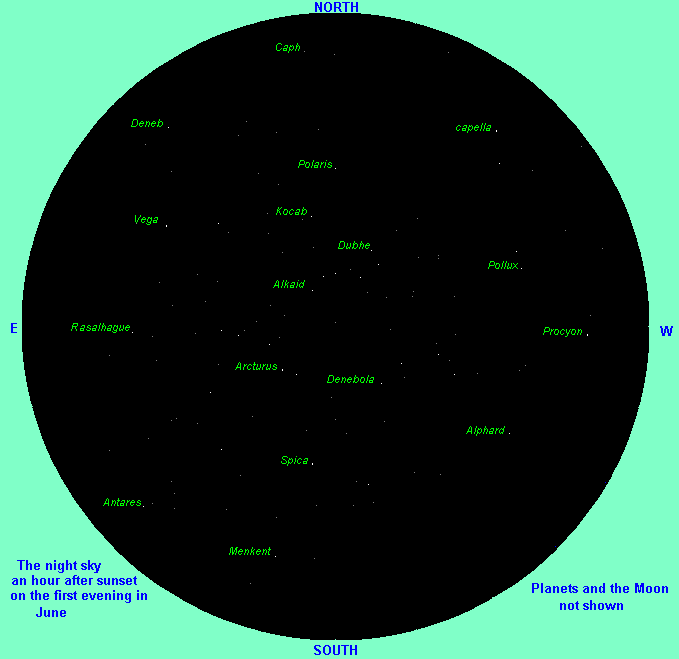 |
On the night of June 24th 1881, William Huggins became the first person to photograph the spectrum of a comet. He discovered that comets, or at least the one he observed, contained cyanogen (CN) - a deadly gas. This small bit of data caused mass hysteria 29 years later when the Earth passed through the tail of Halley's Comet!
On June 30th 1908, something exploded over a part of Siberia called
Tunguska. Fox Mulder thinks it was flying saucer! (They can navigate
through light-years of space and dodge anything along the way,
but they can't make a soft landing?!  ) Agent Scully, along with
the rest of the scientific community, believe it was an asteroid or a bit of a comet
that exploded a few miles above the ground. The explosion was
caused by the incredible heat that built up during its brief passage
through the atmosphere.
) Agent Scully, along with
the rest of the scientific community, believe it was an asteroid or a bit of a comet
that exploded a few miles above the ground. The explosion was
caused by the incredible heat that built up during its brief passage
through the atmosphere.
Valentina Tereshkova, aboard the Vostok 6 spacecraft, became the
first woman in space on June 16, 1963. Hers was, and still is, the
only female solo space flight.
Twenty years and two days later, 18th
of June 1983, Sally Ride became the first American woman in space
aboard the Space Shuttle Challenger (accompanied by Robert Crippen,
Norman Thagard, John Fabian and Fredrick Hauck).
On June 6th 1971, Georgi Dobrovolsky, Vladislav Volkov and Viktor Patsayev docked with the Salyut space station. Twenty three days later (on the 30th of June), after a successful mission in space, all three died during re-entry when their Soyuz 11 spacecraft rapidly lost pressure.
James Christy, of the US Naval Observatory in Flagstaff Arizona, discovered Pluto's satellite, Charon, on the night of June 22nd 1978.
Pioneer 10 became the first spacecraft from the planet Earth to leave the Solar System on June 13, 1983.
I hope you found the Night Sky this Month to be helpful and educational. I invite you to return here monthly for new information.